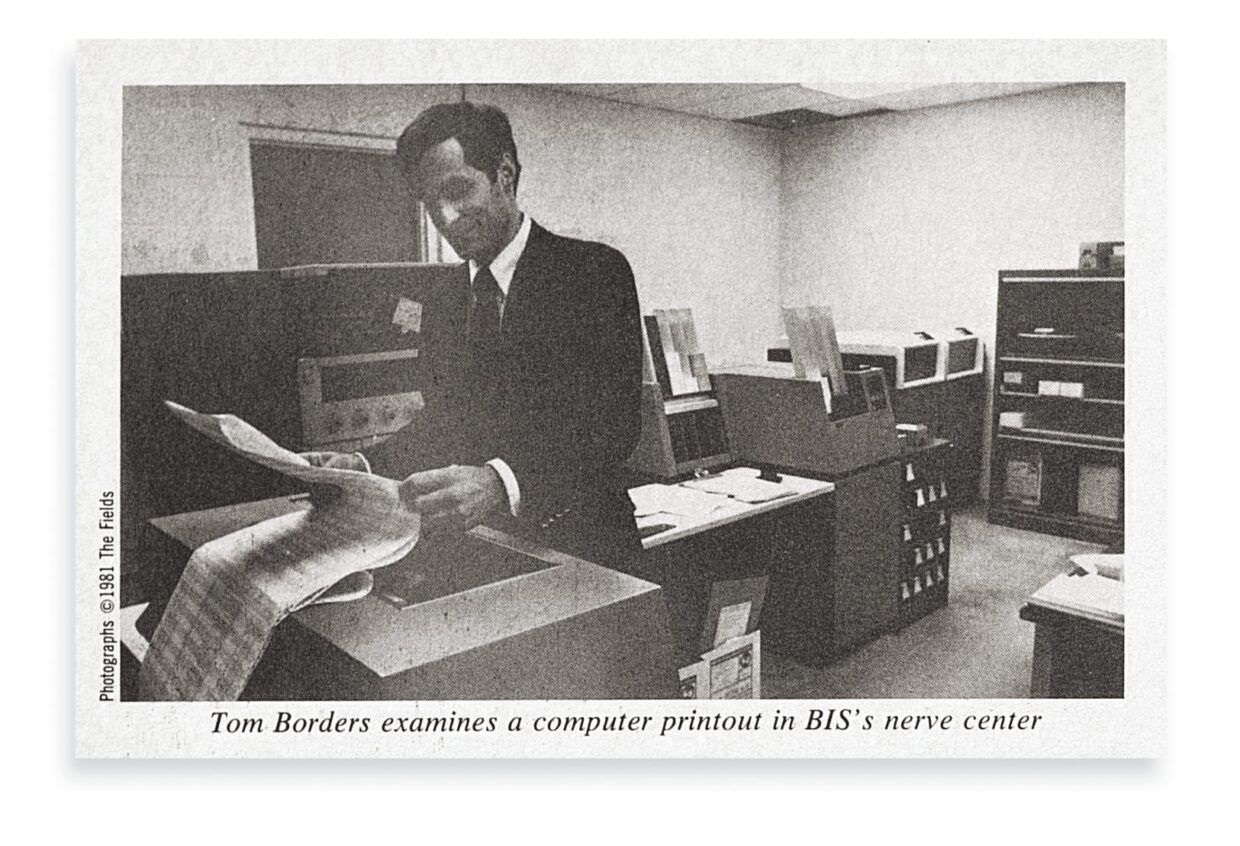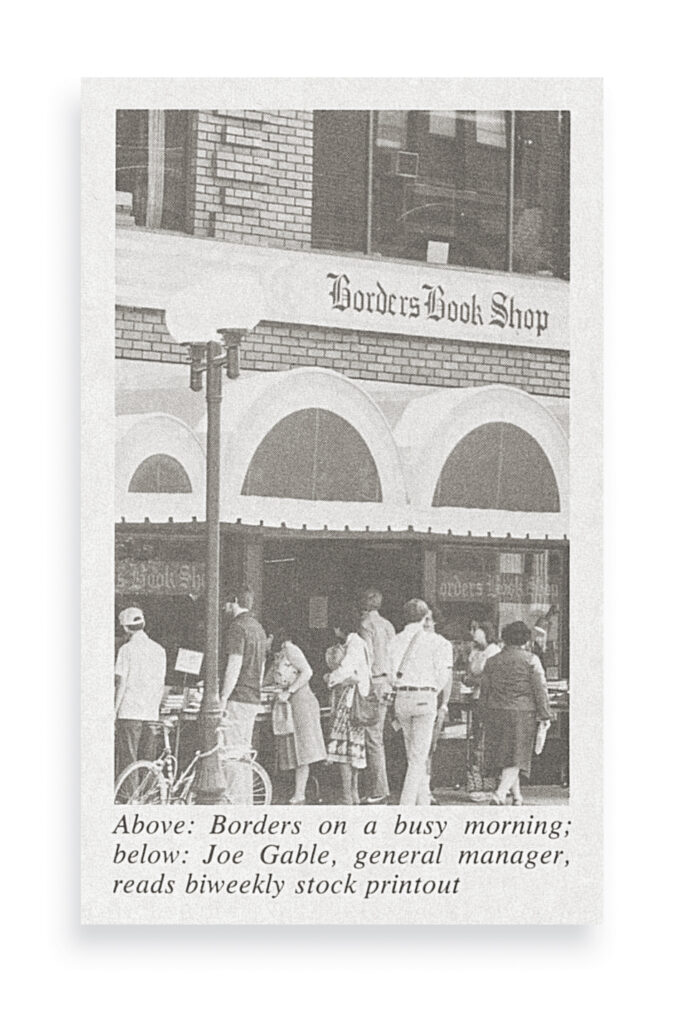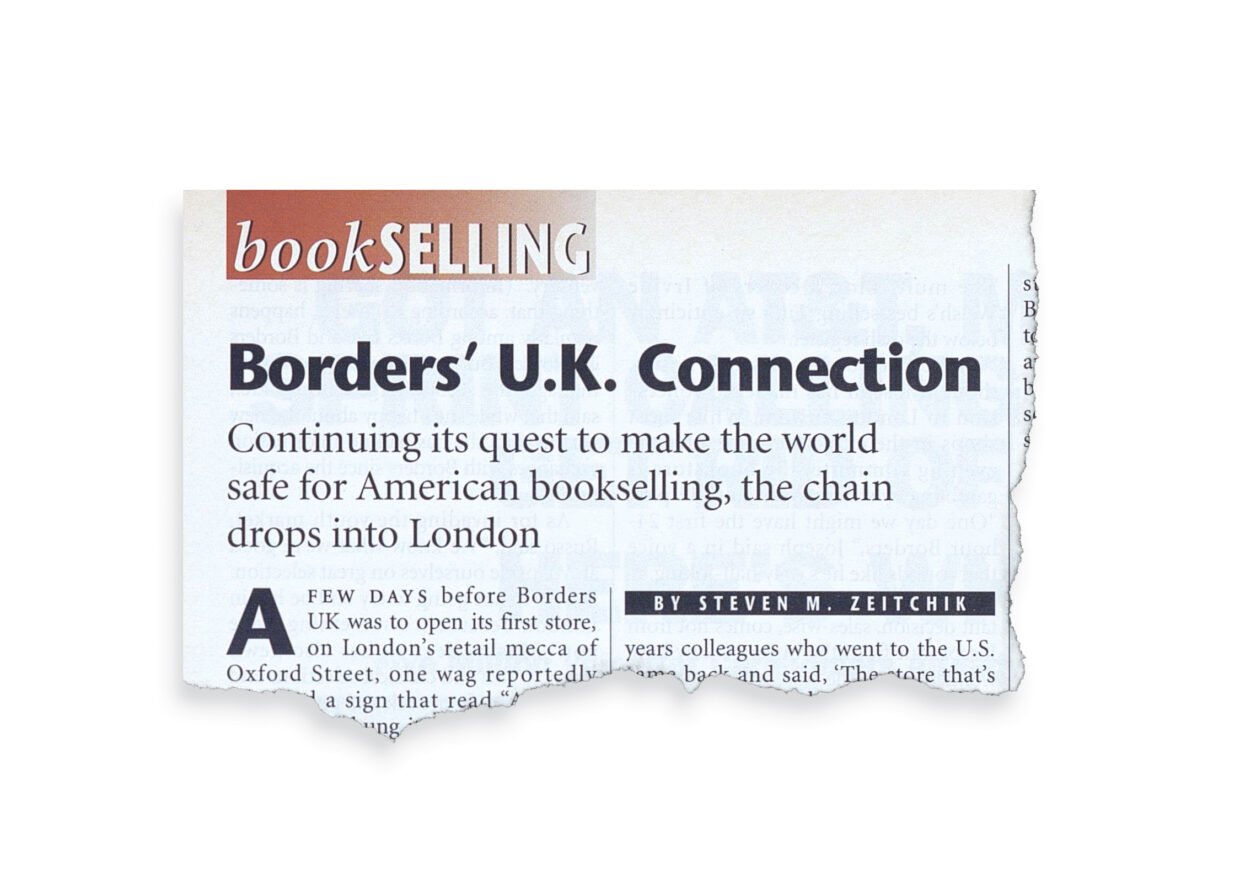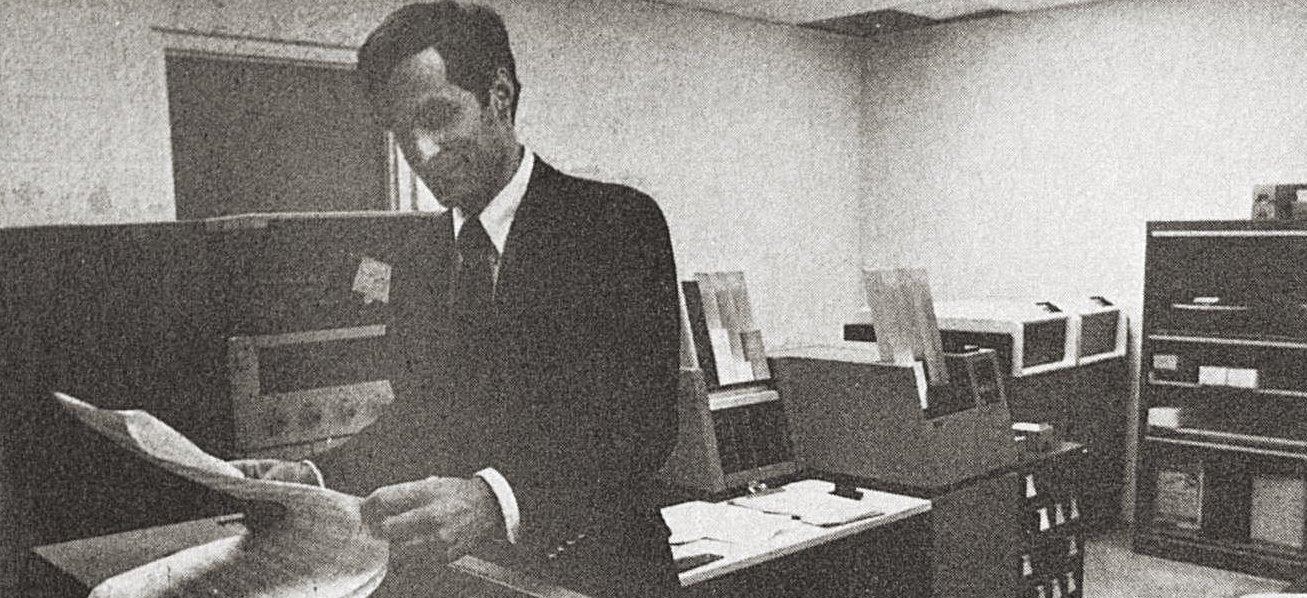The following essay by Tom Borders is excerpted from Among Friends: An Illustrated Oral History of American Book Publishing & Bookselling in the 20th Century, edited by Buz Teacher and Janet Bukovinsky Teacher (Two Trees Press).
*
In 1970, Louis Borders was working in a bookstore in Boston while attending M.I.T. He suggested two start-up business ideas to his older brother, Tom, who had taught English in a small college and was on a sabbatical trying to write the Great American Novel. Tom dismissed Louis’s scheme to computerize the Daily Racing Form’s statistics so they could make an easy living playing the horses. Louis suggested their next best opportunity was to open a small used bookshop in Boston.
During the time they were drawing up business plans for the bookstore, a neighbor in Louis’s apartment building on Boylston Street was burglarized in the middle of the night. The brothers decided Boston was too fast for them—they needed a more manageable city for their little enterprise. Louisville, Kentucky, their hometown, was out of the question because they had never seen much of a bookstore there. Both had degrees from the University of Michigan, and loved the smart, hip, intellectual atmosphere of Ann Arbor.
After discussing the enterprise name for many long weeks, they decided to launch “Borders Book Shop” on a very modest scale, quietly and out of the limelight, in Ann Arbor. No employees. Not a corporate venture. Barely a business. They would keep it very simple. Originally, they thought they would both work half-time and have time to read and write, and become intellectuals.
That same week, Tom and Louis heard about a major estate auction to be held in Boston, with thousands of books as part of the sale. They planned to commit a good part of their capital, up to $3,000, to buy inventory there. At the auction house they spent hours going through the marvelous collection of a man who had been in the Massachusetts Senate in the early 1900s and whose estate had been in litigation for years: hundreds of leather bindings, fine illustrated editions, but best of all a well curated reader’s library.
On auction day, the last items to be sold from the massive estate were the books. The auctioneer apologized because the original intent had been to divide the books into a dozen smaller lots, but since time was so short “we will auction the books in a single lot. Do I have an opening bid of $3,000 dollars?” A dozen people raised their hands including the nonplussed brothers.
By adding to the store space piecemeal, the brothers had drifted into the “superstore” concept quite by accident.Deflated, the Borders’ bookshop fantasy had seemingly vanished. After the auction they met the renowned antiquarian dealer Richard Mills, who had purchased the books for $8,000. A Harvard graduate and World War II Navy submarine vet, he lived in Exeter, New Hampshire. Mills had a photographic memory; he was a true genius and a gentle soul. Somewhat unkempt, he had a bottle of Maalox leaning out of his wrinkled sport coat pocket. Tom asked him if he needed help moving the books, and was hired. Without much further discussion, Richard Mills walked out of the auction house with a small box of rare pamphlets under his arm. The pamphlets were worth the price of the entire lot.

Tom rented a truck and moved the books to Exeter, lured by the excitement of the antiquarian business. Richard Mills’ house was his warehouse, showroom and office. His kitchen table was his service counter and conference table. One day, Tom picked up a collection of about 100 antique duck decoys, which Mr. Mills sold in the next few days to other dealers. Another day, Mr. Mills sold the antique desk in his living room for $16,000.
Later, an 18th-century house full of antiques and collectables came to market. Tom followed Mr. Mills as he strolled through the house, opening a drawer here and there, looking closely at a map. After about 45 minutes of looking through a dozen rooms of antiques, three appraisers quizzed Mr. Mills about the value of the items in the estate. At one point, talking about a mahogany desk where he had opened a drawer during his stroll, Mr. Mills told the appraisers “that is not an antique but a very nicely done 1950’s fake.” All three wrote that in their notes.
After six weeks, Tom had finished sorting and cataloging the books. He was stunned when Mr. Mills gave the Borders brothers his entire garage full of books—a truck load of very good reading copies. They drove their precious first inventory to Ann Arbor, laughing at their good fortune and babbling about their future plans. That day Mr. Mills helped launch Borders Book Shop. It would have been wonderful if he could have lived long enough to see their bookstore ten years later.
In Ann Arbor, they leased part of the second floor of a retail building at 211 South State Street in the campus commercial district near the University of Michigan’s main quad. The former residence had been converted to commercial use. On the same floor were Suwanee Spring Leather Shop, where Tom bought a pair of handmade sandals, and Herb David’s Guitar Studio. Louis and Tom were shaggy-haired hippies who fit right in to the Ann Arbor scene in the early 1970’s. They built bookcases and display tables in the space for a month. They opened their second floor used bookstore in February, 1971, with the books from Mr. Mills and others that they had accumulated. It was tiny—two small rooms with a half bath. Hot tea was made every morning for the customers. The final floor plan included a service counter with the commode tucked behind it. The store had to close for a while if the commode was needed.
Since few customers came into that second-floor space, the brothers had time to learn and love the antiquarian book business in the coming months. Several collectors found them and the books from Mr. Mills’ garage quickly went to new homes in Ann Arbor. Nevertheless, Rookie Mistake #1: they realized that, with their wives in school, two families could not make a living from such a small, off-the-beaten-track, second-floor retail space. They realized that the store could never be very exciting given the space limitations.
Six months later, Tom and Louis moved to a first-floor location on Williams Street: 800 square feet. The additional space was an improvement, but it wasn’t a good location for retailing. They wanted more. They moved for the third time in two years to a prime location at 316 South State St. where Wahr’s University Bookstore had been located “since 1892.” That building was three times larger with a full basement for storage and overstock and an office on the second floor. Neither Tom nor Louis were morning people, but their first employee, Doris Becker, was and she opened the store most mornings. Doris was motherly and very protective of the boys.
Rookie Mistake #2: they ordered some new books and mixed them with used books on the same shelves. Customers were confused, not knowing if a slightly worn new book was “used,” or if a gently used book was “new.”
Rookie Mistake #3: They finally understood that Ann Arbor was a readers’ town and that antiquarian books were of marginal interest to the local avid readers. All the used books were culled from the shelves. After surviving three moves in two years, Borders Book Shop was in a good location with enough space to make a splash, and selling the kind of books people wanted. Their ambitions were rekindled.
That year, Joe Gable, fresh from Madison, Wisconsin, swaggered into Borders Book Shop. During a stand-up job interview in front of the fiction section Tom asked him “What do you know about books?” Sounding a bit like Marlon Brando, looking straight into Tom’s eyes, Joe said humbly: “I know more about books than anyone in this store.” Tom was momentarily stunned by the hubris of the comment. But he took the insult like a man, and after a few pointed questions, he hired Joe on the spot. In fact, Joe did know more about books than anyone in the store. And he proved it over the next quarter century.
The auto industry and the Michigan economy were tanking badly in one of their periodic nose dives in 1974. Several commercial stores were vacant in the campus area. In that down economy, the Borders brothers were able to secure a very favorable lease for a large prime space at 303 S. State Street where Wagner Men’s Clothing had recently closed—10,000 square feet on two levels with an escalator and a full basement!! All new inventory would be ordered for the new store. In preparation for the move, Tom started organizing a clearance sale of everything in the old space.
Louis was mumbling something about “developing a system”—he took several yellow legal pads and went to the basement. Tom was immersed in running a frantic three-month long clearance sale to generate the cash needed for the move; he tried to get Louis to leave the basement to help on the busy sales floor. Louis refused—he was working on designing a “system” for inventory. Glancing at the legal pad, Tom scoffed at a 6-page list which included RANC, RANP, RANM. Tom admits that he did not understand the scope and importance of the momentous project Louis was undertaking. In the next months, Louis designed what was one of the first and likely the best computer system for a retail bookstore in the country. To get the computer system written, tested and running, computer time was rented at night on an IBM System 3 computer in the portable trailer of a massive auto junk yard, with howling guard dogs. The junk yard’s system kept track of auto parts (mostly still on the cars); the Borders’ system would keep track of books.
The store’s book buyers ordered an ambitious selection of books for the 10,000 square foot store. It was a chaotic time, with a clearance sale to the bones going on in the old store while Rudy Fink and his carpentry crew built and varnished solid hardwood bookshelves in the new space. All the while Louis and his buyers were placing huge orders, and he was frantically trying to get the computer system ready to receive a tsunami of books. Occasionally they needed to phone Rudy to get him out of bed in the mornings to manage his bookcase-making crew. In a panic, they hustled to open the store in November, 1974, a few days before Thanksgiving. Two days later, it snowed eight inches which virtually shut down retailing in Ann Arbor. Cash was very tight and Tom was often on the phone with publishers wanting payment.

What seemed like a disaster was averted when, during a booming December, their dream came true—they had a vibrant, exciting bookstore. Joe Gable trained and managed a young, smart staff to provide a specific “Borders Brand” of service: never pushy, cool, friendly, casual, bright. Joe’s crew knew their books, the customers quickly came to rely on the staff and everyone enjoyed the interaction.
They were in their fourth location in three years!! When space became available in an adjacent building, the new space was absorbed. Book titles were added to improve every category throughout the store. They created new categories: Women’s Studies, Gay Studies, and Ecology. Every time they improved a book subject area, such as linguistics, sales in all subjects tended to increase: a customer comes in because she heard about an exceptional selection of linguistic books and she buys a science fiction novel as well. Customers were voracious, and most had never seen such a collection of books. The number of titles in the store increased towards 150,000.
Borders was then larger than most bookstores in the country. Though the brothers had not planned a superstore, their original tiny second floor space had grown in size by a factor of 50, and the quality of the store (selection and service) had increased proportionately. Though a well-run, small, quaint bookstore could still find a place, the high-traffic, high-volume Borders Book Shop in Ann Arbor with its vast selection helped redefine what a bookstore could be in the United States. By adding to the store space piecemeal, the brothers had drifted into the “superstore” concept quite by accident. Mathematically, the formula they discovered was astounding (and over simplified): as their bookstore became larger with better selection, it drew from a larger radius, and it became more exciting, and the sales per square foot increased!
Rookie Mistake #4: Louis and Tom realized that operating a full-blown computer system and employing the specialized subject book buyers and programmers required to maintain a built-from-scratch, one-of-a-kind, stand-alone, sophisticated buying system for over 150,000 book titles was not affordable for a single bookstore. So, in 1976 they started a new company called Book Inventory Systems. The Borders brothers helped individuals open their own stores using their own store name in their own cities and supplied them with a central buying and consolidated shipping. With two shipments a week from Book Inventory’s central warehouse in Ann Arbor, those independent stores often became the best bookstore in their market. Within a few years, in addition the Borders Bookshop in Ann Arbor, Book Inventory System had helped locate, design, and supply stores in East Lansing, Kalamazoo, Toledo, Louisville, Lexington, Cincinnati, Nashville, Memphis, Grand Rapids, Cleveland, and Lexington.
The second Borders Book Shop opened in Birmingham, Michigan in 1985. Joe Gable’s brother, Tim, moved from Montana to Michigan to manage the Birmingham store. Tim, like Joe, was a natural in a bookstore. Borders Book Shop in Birmingham was an instantaneous cultural center in that remarkably literary Detroit suburb. The level and sophistication of sales in the store were a tribute to the affluent community and its education level and value systems. Within two years, sales caught up with the 14-year-old Ann Arbor store. Traveling publishers’ sales reps remarked that both Borders stores were certainly among the top 10 bookstores in the country.
In keeping with Ann Arbor’s egalitarian environment, the Borders brothers installed a company-wide profit-sharing system. While modest at first, good years yielded significant additional pay for the young staff at the stores, which also helped create an esprit de corps, and a sense that this team was doing something important and different.
As they developed the inventory control and distribution systems further, their goal was to have all stores on the system be the best bookstore in their respective markets: best in selection and in service. Inspired by a seminar given by Edward Deming, they strove for continuous improvement.
The company forgot that selling books is not the same as selling sausage or socks.Potential staff in the stores were given a test to assess their literary acumen, to find out if a potential staff member was a “book person” who could help customers and who could contribute to the delicate literary atmosphere. If he didn’t know who Norman Mailer, Frank Lloyd Wright, Julia Child, and Andy Warhol were, should he be working in a bookstore? The staff needed to be well read, communicative, and bright. They needed to offer a high level of service to the customers to compliment the complicated selection of books, without showing too much ego. Often the staff were specialists in certain subjects, such as art, science, literature, or history, allowing them to be more helpful to the customer. Those specialized staffs brought more to the table than typical retail clerks: they were smart, eager to learn and eager to share their knowledge. Furthermore, they helped the buyers improve the selections by adding titles for the system to their assigned subject area. A good bookstore is a glorious business with terrific people.

Borders Book Shops and its affiliated stores were well stocked and well-staffed, and created a refreshing, almost intellectual atmosphere—like a library but with classical music playing in the background, and with the stimulating excitement of discovering and buying a stack of books. The newer stores had coffee shops, and sold CDs and DVDs as an integral part of a very energetic environment.
Book buyers extraordinaire Phyllis Lambert and Robin Wagner, each ran Book Inventory System as interim president for several years. In 1988, Robert DiRomualdo, an Air Force veteran with a degree from Harvard and a strong marketing background, joined Borders as its first outside CEO. DiRomualdo brought enormous energy to the company, and under his leadership, store openings increased rapidly.
In 1992, after 21 years in the business, the Borders Brothers sold Borders Book Shops and Book Inventory Systems, Inc. At that time, the central buying and distribution system supplied about 20 Borders Book Shops and a dozen affiliated independent stores. They sold the businesses to K-Mart, which owned the Waldenbooks chain of bookstores, most located in enclosed malls. Waldenbooks was an asset on Kmart’s books, but was not sexy or profitable. K-Mart was looking for a way to dress up and bundle the Waldenbooks operation to make it saleable.
Borders Book Shops and Waldenbooks were quickly spun off as a single public company on the New York Stock Exchange as “Borders Group Inc.” (BGP) in 1995, with Goldman Sachs as the lead banker. It is curious and significant that combining 1,000 Waldenbooks with a handful of Borders Book Shops and Book Inventory Systems into a public company would be called “Borders Group, Inc.”
At the time they sold, the company had developed a powerful inventory and distribution system, highly effective in allowing the stores to carry more titles and to replenish them more efficiently than most other stores. The “system” had some early characteristics of artificial intelligence to help the book buyers manage the periodic replenishment of the thousands of titles in inventory.
When it became a public company, Borders Group, Inc. continued to be led by Bob DiRomualdo. The Borders brothers were not on the board and had no further input into the operations of the company. Bob had stimulated and managed much of the growth from 1988 to the time of the sale. He retired in 1998 and a bizarre succession of CEOs took over to head up Borders Group, Inc: Phil Pfeffer (1 year); Greg Josefowicz (7 years); Ray Marshall (1 year); Mike Edwards (1 year), and Bennett LeBow (1 year).
In 2011, nineteen years after the Borders brothers sold the business and sixteen years after becoming a public company, Borders Group Inc. filed for bankruptcy. All of the stores were closed. Thousands of booksellers lost their jobs. It was a very sad day in America when over 1,000 bookstores, each a mini-cultural center, a source of wisdom and good, healthy information and entertainment, shuttered their doors. And the closings felt like a kick in the stomach to the brothers.
There are many theories about what went wrong. But a series of non-Rookie Mistakes occurred: a far too rapid expansion in United States (40+ superstores were opened in 1998 alone, the year DiRomualdo left the company); a confusing international expansion (London, Singapore, New Zealand, Australia) and lack of control of the supply chain; changing leadership too often as each new CEO jerked the fast changing company in a different direction; poor financing machinations; poor real estate decisions; lack of understanding of the delicate nature and required quality of a great bookstore: the company forgot that selling books is not the same as selling sausage or socks.
At its peak, Borders Book Shop was a beautiful exhibition of the great freedoms Americans enjoy, with a broad selection of American publishers’ offerings, without a single government comment. It was also a bold experience in aggressive capitalism mixed with a strong dose of intellectual endeavor to create a unique setting for the American public.
Though gone, Borders Book Shops are still remembered by some. Their absence has left a hole in the fabric of society in many American cities.
__________________________________

This is one of more than 100 essays by prominent industry figures in Among Friends: An Illustrated Oral History of American Book Publishing & Bookselling in the 20th Century, edited by Buz Teacher and Janet Bukovinsky Teacher (Two Trees Press). Illustrated with vintage book jackets and period graphics from Publishers Weekly, Among Friends is a deluxe limited edition that pays homage to the creative and entrepreneurial spirit of the book business during a time of great change in American culture.



